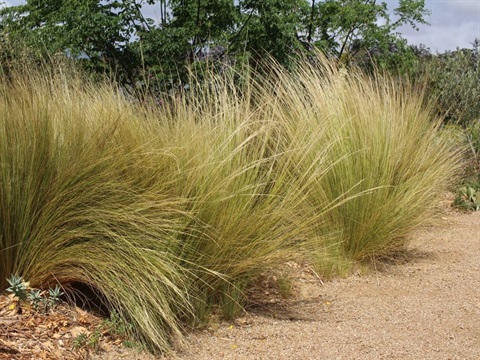Weed of the Week: Mexican Feather Grass
Published on 24 October 2022

Snowy Monaro Regional Council is calling on all community members to get to know our region’s weeds so we can all play our part in protecting our environment, helping our farmers and supporting our community.
The impact of weeds on our community can be devastating and is estimated to cost the NSW economy about $1.8 billion annually (NSW Department of Industry, 2018).
This is the fourth article in our Weed of the Week series, where we’ll be sharing information on our region’s priority weeds, this week focusing on Mexican Feather Grass (Nassella tenuissima).
What is Mexican Feather Grass?
Mexican Feather Grass is a highly invasive, exotic, perennial, grassy weed – closely related to Serrated Tussock, one of Australia’s worst pasture weeds.
Plants grow in large tussocks, with a maximum height of 70cm. Central growth is typically taller than the outer edge and often droops over. Edges usually grow shorter and away from the plant.
Leaves are up to half a centimetre wide and up to 60cm long, tightly rolled, overlapped at their edges, smooth if you roll them between your fingers and coarse if you slide your fingers down the leaf.
Mexican Feather Grass has a small, thin structure at the base of the leaf blade. This is a ligule and can look like a small piece of tissue paper.
As with many grassy plants, it is typically easiest to identify Mexican Feather Grass by its seed-heads. They are found on a round, smooth and hairless spike on stems up to 80cm long. They cluster in groups at the end of the spike with a sheath that looks like a leaf.
Seeds are 2–3 mm long, found inside purple/reddish-brown glumes with an awn (bristlelike appendage like a beard of wheat or barley) at the end.
Why is Mexican Feather Grass a problem?
Mexican Feather Grass is Prohibited Matter in NSW. It is illegal to buy, sell or possess the plant, and upon detection must be reported immediately.
It is closely related to Serrated Tussock which is one of the worst pasture weeds in Australia. Much of Australia is in the natural range of Mexican Feather Grass and if allowed to spread, it could easily become a bigger problem than Serrated Tussock.
Additionally, it has been sold mislabelled by retailers in NSW and made its way into gardens and landscaping installations across the state and ACT.
The risks posed to the Snowy Monaro from Mexican Feather Grass include that it:
- takes over pastures
- is unpalatable to stock and reduces pasture quality
- contaminates hay and grain
- invades native grasslands and woodlands.
- is hard to get rid of
What can you do?
- Learn to identify Mexican Feather Grass
- Search your property for any sign of this priority weed
- This weed must be eradicated and Council must be notified of any infestation.
If you find suspected Mexican Feather Grass on your property, contact Council’s Biosecurity officers immediately.
Our team will provide you with the necessary assistance to eradicate Mexican Feather Grass before it can spread further.
Download the free NSW WeedWise app for detailed information on how to identify and manage local priority weeds. Visit www.dpi.nsw.gov.au/biosecurity/weeds
Visit Council’s website to understand how we can help you with weed management. www.snowymonaro.nsw.gov.au/Environment-Waste-and-Weeds/Biosecurity-and-Weeds
Visit the Department of Primary Industries (DPI) website for information on weed control methods – www.dpi.nsw.gov.au/biosecurity/weeds/weed-control
Contact Snowy Monaro Regional Council if you have any questions regarding weeds on your property or in your neighbourhood. Call 1300 345 345 to be connected to our Biosecurity Officers who specialise in weed management.